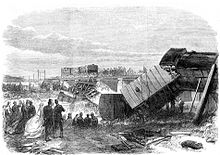Staplehurst Railway Accident
The Staplehurst , Kent railway accident was a bridge collapse under a moving train during construction on the South Eastern Main Line at the bridge over the Bump , a tributary of the Medway , on June 9, 1865. The accident killed 10 passengers and injured 40 . One of the passengers on the train was the writer Charles Dickens .
Framework
As Tidal were Boat Trains called, trains the connection between London manufactured and ship to the continental mainland, the tide dependent wrong because the port of Folkestone was not yet run to tide free. This required a daily changing timetable .
On the day of the accident, construction work was taking place on the route at Staplehurst . A foreman had rails removed from the bridge over the bulge for the work . The route had to be secured according to regulations with marshals and bang capsules .
the accident
The foreman made two mistakes: he neglected to have the detonators installed and he mistakenly expected the train to arrive later. The track system was not restored in time when the tidal approached Folkestone, which was occupied by travelers from a ship connection from France. The prescribed marshals , which were supposed to signal the danger to trains , were not, as prescribed, 1,000 yards (910 m), but only 554 yards (507 m) in front of the construction site. The train could no longer brake in time and drove over the gap between the rails at around 50 km / h. The locomotive was still sliding over the wooden beams on which the rails should have been mounted on the bridge, but the impact of the derailing train on the bridge broke the cast iron bridge girders. The locomotive , tender and a baggage car remained on the track, the following passenger car got stuck on the bridge relatively unscathed after its crash (Charles Dickens was traveling in it), the following vehicles crashed, only the last three remained on the track again.
Examination result
In addition to the failures to secure the construction site, there were also complaints about the bridge's construction, which did not have any additional safeguards to prevent vehicles from falling.
Literary precipitation
The writer Charles Dickens returned from Paris and was in the first passenger coach (in the picture it's the one hanging halfway from the bridge). Dickens got away physically unharmed, but was psychologically traumatized by the accident , which is said to have contributed to his relatively early death in 1870. He has had major problems since then when he had to travel by train and tried to avoid it if possible. He described the accident in the epilogue to the novel Our Mutual Friend , which he had worked on during the trip. After helping dying and injured travelers, he climbed back into the car to rescue the manuscript of the book. Shortly after the accident, he wrote the short story The Signal-Man , a ghost story about a railroad accident. However, this draws more from the events of the railway accident in the Clayton Tunnel , which occurred in 1861.
The Staplehurst railway accident was also processed in the plot of Ronald Frederick Delderfield's " God is an Englishman " (Swann Saga) and the accident is the starting point of the novel Drood from 2009 by Dan Simmons .
Web links
- Official investigation report of the captain of the pioneers Rich. (PDF; 480 kB)
- Letter from Charles Dickens, which he wrote immediately after the accident and in which he describes his experience.
- Charles Dickens and the accident.
- Private side of the accident
literature
- Peter R Lewis: Dickens and the Staplehurst Rail Crash = The Dickensian 104 (476), p. 197 (2009).
- Peter R Lewis: Disaster on the Dee. Robert Stephenson's Nemesis of 1847 . Tempus 2007. ISBN 978-0-7524-4266-2
- Oswald Stevens Nock : Historic Railway Disasters . 3rd ed. London 1983, pp. 15-19. ISBN 0-7110-0109-X .
- Lionel Thomas Caswell Rolt : Red for Danger . Edition: London 1978. ISBN 0-330-25555-X
- Wolfgang Schivelbusch: History of the railway journey. On the industrialization of space and time in the 19th century . Frankfurt 1989. ISBN 3-596-24414-5 , pp. 123f.
See also
Individual evidence
- ^ Rolt: Red for Danger , p. 127.
- ^ Rolt: Red for Danger , pp. 127-128.
- ^ Rolt: Red for Danger , p. 130.
- ↑ Epilogue to Our Mutual Friend (PDF; 10.4 MB)
- ↑ 1970; German : God is English (1972).
Coordinates: 51 ° 10 ′ 9.3 " N , 0 ° 34 ′ 48.7" E
